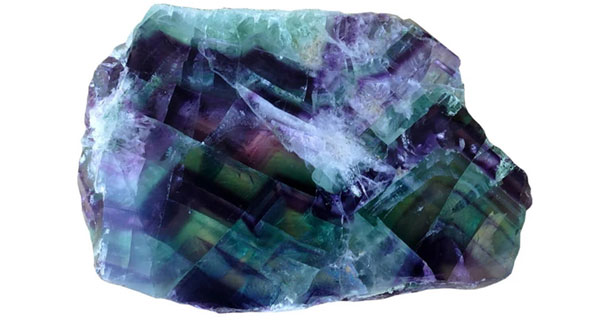Fluorite (also called fluorspar) is a mineral composed of calcium fluoride, CaF2. The
name is derived from the Latin word “fluere” meaning “to flow”, because it melts very easily
to a free-flowing liquid. In fact, the name of the element fluorine is named so because it is a
major constituent of fluorite. Fluorine is widespread in different compounds but not found in
free state due to its strong chemical affinity. Its crustal incidence has been estimated to be 597
ppm and the seawater contains 1.3 mg/litre. The important minerals containing fluorine are:
(a) Fluorite (CaF2)
(b) Fluor-apatite [ 3Ca3(PO4)2.Ca(Cl,F)]
(c) Cryolite (Na3AlF6)
Of these, fluorite is commercially the most significant.
Fluorite is a common mineral in deposits of hydrothermal origin, as a primary mineral in
granites and other igneous rocks and as a common minor constituent of dolomite and
limestone. It may also occur as a vein deposit, especially with metallic minerals, where it
often forms a part of the gangue and may be associated with galena, sphalerite, barytes,
quartz, and calcite. Fluorite is a widely occurring mineral. Notable deposits occur in
Germany, Austria, Switzerland, England, Norway, Mexico, Kenya, USA and Canada. At
Wagon Wheel Gap, Colorado, USA, fluorite is a major constituent of hot spring deposits. It is
also sometimes found in pegmatite.
PROCESSED GRADES
Crude fluorite is processed by both hand-sorting and beneficiation. For hand-sorting, the
mineral is crushed to around 10 mm size pieces that can be visually discerned by labourers.
But this is suitable when the run-of-mine grade is relatively high to enable the workers to
visually identify the mineral and a not very high grade output is desired. For getting high
grade output from finely disseminated low-grade mineral, beneficiation by flotation is
employed. Also, the flotation process makes it possible to recover lead and zinc values if
associated with the fluorite. The chemical process involving acidulation is employed for
recovering fluorite from phosphate rock.
In India, the cut-off grade for hand-sorting is 30% CaF2 while the mill-feed grade for
beneficiation is 24% ± 5% CaF2, 3-5% CaCO3, 0.7-1.7% P2O5 and 55-65% SiO2. The output
after processing is standardized in terms of three marketable grades as follows.
Acid or chemical grade: This grade of fluorite should ideally contain a minimum of
97% CaF2 and up to 1.5% SiO2. For ordinary products, however, 93% CaF2 is
acceptable as in India.
Ceramic grade: For high-quality ceramic products, fluorite containing a minimum of
95% CaF2, up to 2.5% SiO2 and up to 1.5% CaCO3 is generally considered standard
in USA. But strictly speaking, there is no standard grade and it is highly variable
Fluorite (Fluorspar) 177
depending on the quality of the finished product, and for very ordinary cheap
products, low grade fluorite can also be used.
Metallurgical grade: This grade is expressed in terms of what is called effective units
of CaF2. Effective CaF2 is determined by subtracting 2.5 units for every unit of SiO2.
Determined thus, the effective CaF2 should be at least 60 per cent, which is the same
as 80% CaF2 and 8% SiO2. But the maximum grade can go beyond 97% CaF2 with
maximum 1% SiO2.
